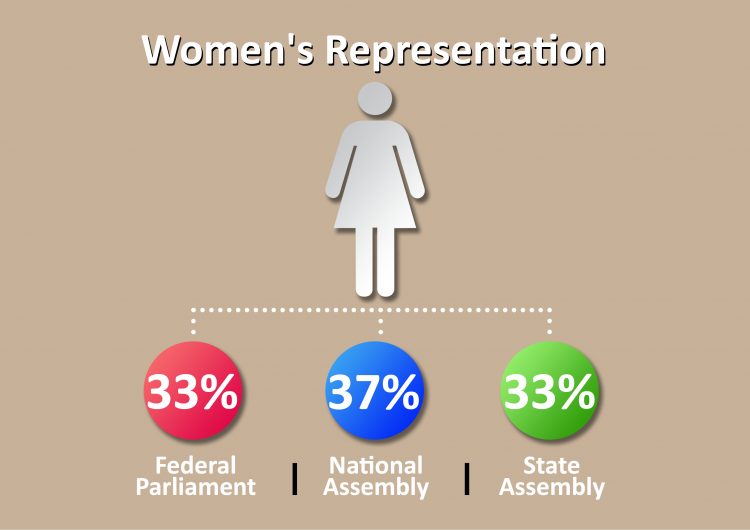Women’s representation will increase after elections
Sujit Mainali / March 8, 2017

Graphic: Bikram Rai
The Constitution of Nepal-2015 has several provisions for increasing women’s representation in the elected bodies. If the elections of all three levels (federal parliament, provincial parliament and local level) are held in accordance with the constitution, representation of women in these bodies will increase.
Federal Parliament
Article 84(1) of the constitution has mentioned that the House of Representatives shall consist of a total of 275 members. According to Clause 8 of Article 84, at least one-third of the total number of members elected from each political party represented in the federal parliament must be women. If women are not elected so as to constitute one-third of the elected members of any political party through the first-past-the-post electoral system and through electoral college for the national assembly, such a party must elect women under the proportionate electoral system to make up for the deficit number.
National Assembly
Article 86(2) of the Constitution has mentioned that the National Assembly shall consist of 59 members. Clause 2(a) of this article states that at least three women from each province must be elected to the National Assembly. Through this provision, at least 21 women members will be elected to the National Assembly.
According to Clause 2(b) of this Article, at least one among the three members of the National Assembly nominated by the President on the recommendation of the Government of Nepal must be a woman.
With these provisions, at least 22 women members will be in the National Assembly, which is around 37 percent of the total members.
State [provincial] Assembly
Article 176 (9) of the constitution has mentioned that at least one-third of the total number of the members elected from each political party to the State Assembly must be women. If women are not elected so as to constitute one-third of the elected members of any political party through the first-past-the-post electoral system, such party must elect women under the proportionate electoral system to make up for the deficit number.
Village Executive [body]
Article 215(4) mentions that the four women members elected to the Village Assembly will be the member of Village Executive [body].
Municipal Executive [body]
Article 216(4) mentions that five women members elected to the Municipal Assembly will be the member of Municipal Executive [body].
District Coordination Committee
Article 220(3) mentions that the District Assembly shall elect the District Coordination Committee consisting of a maximum of nine members including at least three women. The District Coordination Committee shall discharge all functions required to be discharged by the District Assembly.
Village Assembly
According to Article 222, a Village Assembly shall have representation of at least two women from each ward.
Municipal Assembly
According to Article 223(3), a Municipal Assembly shall have representation of at least two women from each ward.
This material is copyrighted but may be used for any purpose by giving due credit to southasiacheck.org.
Comments
Latest Stories
- In Public Interest Covid-19 cases are low, but that’s not an excuse to avoid vaccination
- In Public Interest What is BF.7, the sub-variant that has the world by its grip?
- In Public Interest Threat of a new Covid-19 wave looms large amid vaccine shortage in Nepal
- In Public Interest As cases decline, Covid-19 test centres in Kathmandu are desolate lot
- In Public Interest Dengue test fee disparity has patients wondering if they’re being cheated
- In Public Interest As dengue rages on, confusion galore about what it is and what its symptoms are. Here’s what you need to know
In Public Interest
 Covid-19 cases are low, but that’s not an excuse to avoid vaccination
The Pfizer-BioNTech bivalent vaccines authorised by the Nepal Government provide better protection a...
Read More
Covid-19 cases are low, but that’s not an excuse to avoid vaccination
The Pfizer-BioNTech bivalent vaccines authorised by the Nepal Government provide better protection a...
Read More
- What is BF.7, the sub-variant that has the world by its grip?
- Threat of a new Covid-19 wave looms large amid vaccine shortage in Nepal
- As cases decline, Covid-19 test centres in Kathmandu are desolate lot
- Dengue test fee disparity has patients wondering if they’re being cheated
- As dengue rages on, confusion galore about what it is and what its symptoms are. Here’s what you need to know